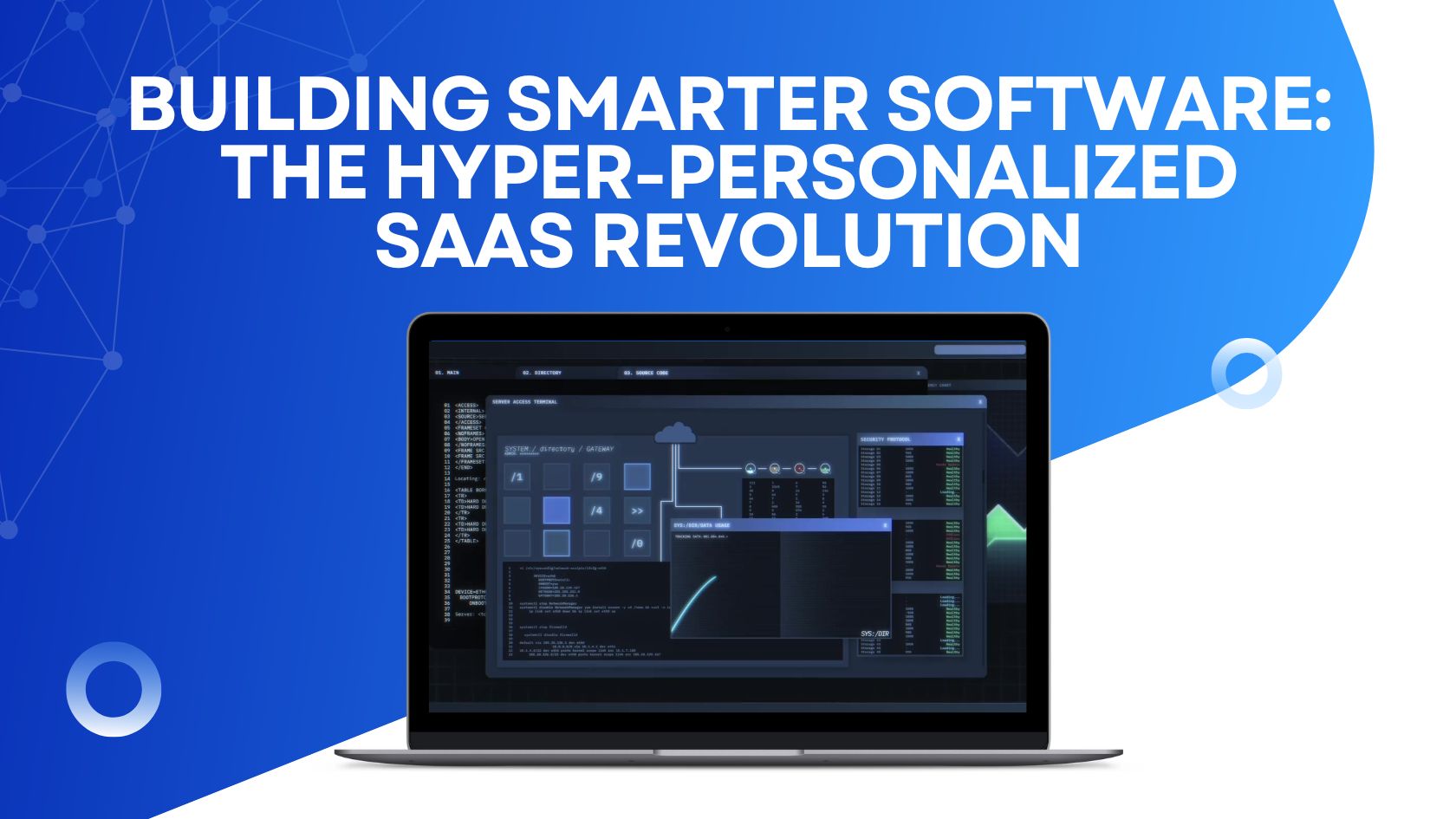The Shift Toward Hyper-Personalized Digital Experiences
The software world is changing faster than ever before. Traditional SaaS platforms—once built with fixed features and broad, one-size-fits-all workflows—are now being replaced by smarter, adaptive, and deeply personalized user experiences. Today’s customers expect software that understands their needs, predicts their actions, and shapes itself around the way they work. This shift has given birth to the Hyper-Personalized SaaS Revolution, a new era where artificial intelligence, real-time analytics, and user-behavior modeling turn simple tools into intelligent digital partners.
In this article, we explore how hyper-personalization is transforming the SaaS ecosystem, why users demand it, and how businesses can adopt it to stay competitive in the new digital future.
1. Why Personalization Is the New Standard—Not a Luxury
Customers no longer want generic software experiences. They want platforms that feel uniquely designed for them—intuitive dashboards, customized workflows, and intelligent recommendations. Studies show that users stay longer, convert better, and return more frequently when they interact with personalized systems.
The rise of AI-driven personalization is driven by three core reasons:
• Information Overload
Modern users manage countless apps, dashboards, and tools. Personalized interfaces reduce overwhelm by showing only what matters.
• Efficiency and Speed
Hyper-personalized SaaS removes unnecessary steps, automates repeated tasks, and shortens decision-making time.
• Higher User Expectations
Netflix, Amazon, and Spotify have set the gold standard with tailored feeds—users now expect the same intelligence in business software.
As these expectations grow, SaaS companies must evolve from functional tools to intelligent experiences.
2. What Exactly Is Hyper-Personalized SaaS?
Hyper-personalization is the next evolution of traditional customization. It goes beyond allowing users to manually tailor their interface—it uses machine learning, real-time behavioral data, and predictive analytics to automatically adapt the software to each user.
Key elements of hyper-personalized SaaS include:
- AI-driven recommendations (suggested actions, content, workflows)
- Behavior-based interface adaptation
- Predictive task automation
- Dynamic dashboards that evolve with usage patterns
- Contextual insights based on user role, past actions, or industry
- Real-time personalization engines
This approach transforms software from a static tool into a system that learns, improves, and grows with each user.
3. The Technology Powering Hyper-Personalized SaaS
Behind every personalized software experience lies a powerful technological foundation. The hyper-personalized revolution depends on a blend of modern tools working together to provide real-time intelligence.
a. Machine Learning (ML)
ML analyzes past user behavior to identify patterns and anticipate future actions.
It enables features such as:
- Predictive search
- Automated recommendations
- Personalized task suggestions
b. Artificial Intelligence (AI)
AI enhances personalization by enabling natural language understanding, intelligent automation, and dynamic decision-making. With AI, SaaS platforms can act like smart assistants—offering guidance, simplifying workflows, and predicting user needs.
c. Data Analytics & User Behavior Tracking
Every click, scroll, and action becomes a data point. Behavioral analytics help the software understand user intent, preferences, and pain points.
d. Cloud-Native Architecture & Microservices
To deliver real-time personalization at scale, SaaS products rely on microservices, containerized environments, and cloud platforms like AWS, Azure, or GCP.
e. APIs & Integrations
External data sources—CRM platforms, payment tools, productivity apps—fuel deeper personalization by giving the system a broader understanding of the user.
This technological stack makes hyper-personalization not just possible but scalable, stable, and deeply integrated.
4. How Hyper-Personalization Improves SaaS User Experience
The key to SaaS success is user satisfaction. When software adapts naturally to user needs, everything becomes easier, faster, and more intuitive.
• Dynamic User Journeys
Instead of forcing every user through the same steps, a smart SaaS platform adjusts the onboarding process, dashboard, or workflow based on individual behavior.
• Smart Workflows & Task Automation
AI detects repetitive actions and automates them—saving hours each week.
• Personalized Dashboards
Every user sees metrics, charts, or tools most relevant to their job role.
• Contextual Help & Real-Time Guidance
Support is delivered at the exact moment a user needs it—improving adoption and reducing churn.
• Higher Engagement & Lower Churn
When users feel that the software “understands” them, they stay longer and interact more often.
This is the core advantage of the hyper-personalized revolution: it transforms software from a tool into an experience.
5. Hyper-Personalization in Action: Real Use-Case Examples
1. CRM Platforms
Sales reps see follow-up recommendations, lead prioritization, and personalized outreach suggestions based on past performance.
2. Project Management Tools
Tasks get automatically sorted by urgency, past behavior, workload trends, and deadlines.
3. E-commerce SaaS
Merchants get AI-powered pricing suggestions, product recommendations, and tailored marketing workflows.
4. HR Platforms
Employees receive personalized training modules, role-based dashboards, and adaptive onboarding content.
5. Marketing Automation Tools
The system predicts audience segments, content choices, and sends optimized messages automatically.
These examples show how personalization can touch every industry and improve every workflow.
6. The Business Benefits of Building Hyper-Personalized SaaS
Beyond improved user experience, personalization drives powerful business outcomes.
• Higher Conversions
Onboarding becomes smoother, reducing friction and increasing trial-to-paid conversions.
• Increased User Retention
Personalized experiences keep users coming back. They feel the product is built for them.
• Faster Product Adoption
Contextual guidance makes learning easier and reduces support tickets.
• Stronger Competitive Advantage
Hyper-personalized SaaS stands out in crowded markets where generic tools fail to impress.
• Revenue Growth
Through upselling, cross-selling, and customer loyalty, hyper-personalization directly increases revenue.
This is why leading SaaS companies are investing heavily in ML and AI-driven customization.
7. Challenges You Must Overcome When Building Hyper-Personalized SaaS
Powerful personalization requires careful handling. Before building such systems, SaaS companies must address several challenges:
• Data privacy & compliance (GDPR, CCPA, etc.)
User data must be protected, encrypted, and handled responsibly.
• ML model accuracy
Poor recommendations damage trust. Models must be trained properly.
• Excessive personalization risks
Overpersonalization may overwhelm or confuse users.
• Infrastructure complexity
Real-time personalization requires strong cloud architecture.
• Scalability
More users mean more data, more predictions, and higher processing costs.
While challenging, these issues can be solved with proper planning and execution.
8. The Future of SaaS: Adaptive, Predictive, and Emotionally Intelligent
The next generation of SaaS platforms won’t just automate tasks—they will understand your goals, anticipate needs, and reshape experiences around you. As AI becomes more sophisticated, SaaS systems will integrate:
• Emotional AI (systems that detect frustration or satisfaction)
• Self-optimizing UI that rearranges itself in real time
• Predictive workflows that finish tasks before users start them
• Cross-app intelligence (software sharing insights between tools)
• Voice-driven dynamic SaaS interfaces
Hyper-personalization is only the beginning. The future of SaaS is adaptive, intuitive, and human-centered.
Conclusion: The Hyper-Personalized Revolution Has Already Begun
SaaS companies that embrace hyper-personalization gain loyal users, higher engagement, and long-term growth. Those that don’t will be replaced by smarter, AI-powered alternatives.
Whether you’re building a new SaaS product or transforming an existing one, personalization should no longer be optional—it’s the foundation of modern software success.
Businesses that invest in personalization today will define the future of the SaaS industry tomorrow.
The revolution has begun. The only question is: Are you ready to build smarter software?


Leave a Reply